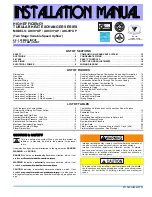
26
3. Knowing the furnace model, locate the high stage cooling
air flow charts in the Product Data Book applicable to your
model* . Look up the cooling air flow determined in step 2
and find the required cooling speed and adjustment setting.
Example:
A 70 kBtu furnace is to be installed with a 2.5
ton air conditioning system. The air flow
needed is 1000 CFM. Using the cooling speed
chart for the 70 kBtu furnace, find the airflow
closest to 1000 CFM. A cooling airflow of 990
CFM can be attained by setting the cooling
speed to “C” and the adjustment to “-” (minus).
NOTE:
Continuous Fan Speed will be 56% of
high stage cooling.
4. Locate the blower speed selection DIP switches on the
integrated control module. Select the desired “cooling”
speed tap by positioning switches 1 and 2 appropriately.
Select the desired “adjust” tap by positioning switches 3
and 4 appropriately. Refer to the following figure for switch
positions and their corresponding taps. Turn off power to
furnace for a minimum of 10 seconds, allowing motor to
reset and recognize new speed selection. Turn on power
to furnace. Verify CFM by counting the number of times the
green CFM LED blinks.
5. The multi-speed circulator blower also offers several custom
ON/OFF ramping profiles. These ramping profiles may be
used to enhance cooling performance and increase comfort
level. The ramping profiles are selected using DIP switches
5 and 6. Refer to the following figure for switch positions
and their corresponding taps. Refer to the bullet points below
for a description of each ramping profile. Turn off power to
furnace for a minimum of 10 seconds, allowing motor to
reset and recognize the new profile selection. Turn on power
to the furnace. Verify profile selection by counting the green
CFM LED blinks and timing each step of the ramping profile
•
Profile A provides only an OFF delay of 1 minute at 100% of
the cooling demand airflow.
100% CFM
1 min
100% CFM
Cooling
Demand
OFF OFF
• Profile B ramps up to full cooling demand airflow by first
stepping up to 50% of the full demand for 30 seconds. The
motor then ramps to 100% of the required airflow. A 1 minute
OFF delay at 100% of the cooling airflow.
OFF
100% CFM
Cooling Demand
100% C FM
1 min
50% CFM
OFF
½ min
•
Profile C ramps up to 82% of the full cooling demand airflow
and operates there for approximately 7 ½ minutes. The motor
then steps up to the full demand airflow. Profile C also has
a 1 minute/100% OFF delay.
100% CFM
100% CFM
1 min
82% CFM
Cooling Demand
7 ½ min
OFF
OFF
•
Profile D ramps up to 50% of the demand for ½ minute,
then ramps to 82% of the full cooling demand airflow and
operates there for approximately 7 ½ minutes. The motor
then steps up to the full demand airflow. Profile D has a 1/
2 minute at 50% airflow OFF delay.
100% CFM
50% CFM
½
min
82% CFM
Cooling Demand
7 ½ min
OFF
OFF
50% CFM
½ min
Ramping Profiles
(*indicates factory setting)
Ramping
Profile
Tap A
Ramping
Profile
Tap B
Ramping
Profile
Tap C
Ramping
Profile
Tap D
8 7 6 5 4 3 2 1
O
F
F
O
F
F
8 7 6 5 4 3 2 1
O
F
F
O
F
F
8 7 6 5 4 3 2 1
O
F
F
O
F
F
8 7 6 5 4 3 2 1
O
F
F
O
F
F
*
6. Select the heating speed from the heating speed chart in
the Product Data Book applicable for your model*. The
adjust setting (already established by the cooling speed
selection) determines which set of speeds are available.
The selected speed must provide a temperature rise within
the rise range listed with the particular model.
Example:
The 70 kBtu is set for 990 CFM on cooling,
the “ADJUST” is set to “-” (minus). The four
heating speeds available are “A Minus”, “B
Minus”, “C Minus”, and “D Minus”. “B Minus”
has a rise of 56
°
F for both stages which is
within the 30-60°F rise range for the 70 kBtu.
This setting will keep electrical consumption
to a minimum. Set the “Heat” speed DIP
switches to “A”.
7. Select the desired “heating” speed tap by positioning
switches 7 and 8 appropriately. Refer to figure above. Turn
off power to furnace for a minimum of 10 seconds, allowing
motor to reset and recognize new speed selection. Turn on
power to furnace. Verify selected CFM by counting the green
CFM LED blinks.
In general lower heating speeds will: reduce electrical consumption,
lower operating sound levels of the blower, and increase the outlet
air temperature delivered to the home. The speeds available allow
the blower performance to be optimized for the particular
homeowner’s needs.



































